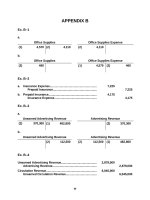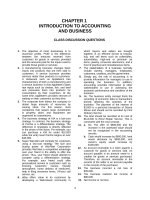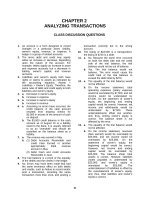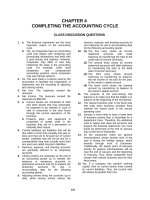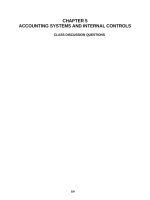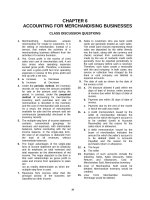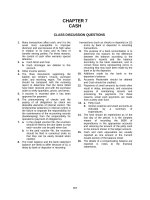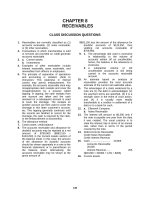Solution manual investments 10th by jones ch06
Bạn đang xem bản rút gọn của tài liệu. Xem và tải ngay bản đầy đủ của tài liệu tại đây (199.07 KB, 21 trang )
Chapter 6: The Returns and Risks From Investing
CHAPTER OVERVIEW
The purpose of Chapter 6 is to present an analysis of risk
and return early enough in the text for these concepts to be used
throughout the book. Return and risk are the key elements of
investment decisions--in effect, everything else revolves around
these two factors. It makes sense, therefore, to analyze and
discuss these concepts in detail.
Chapter 6 focuses only on understanding and measuring
realized returns and wealth. This allows students to concentrate
on this one issue, in a comprehensive manner. All of the
equations for calculating various types of returns are included
in this chapter, providing a complete package in this regard. It
is doubtful that beginning students could need any more than what
is contained here with regard to realized returns.
Chapter 6 provides a complement to Chapter 7, which covers
expected returns and risk and the basic calculations of portfolio
theory. Thus, in Chapter 6 we analyze and calculate realized
returns, while in Chapter 7 we analyze and calculate expected
returns, based on probability distributions.
This discussion centers around the definition and meaning of
return and risk, including the components of return, the sources
of risk, and types of risk. The emphasis is on how to both
understand and measure return and risk. Considerable attention
is devoted to explaining the total return (TR), return relative
(RR), and cumulative wealth calculations, which are used
throughout this text and are exactly comparable to the
definitions used in such prominent sources as the Ibbotson
Associates Yearbook. Numerous examples of these important
calculations are presented.
The discussion of returns measures facilitates the
presentation of the data on rates of return and wealth indexes.
This data is both important (as benchmarks) and interesting (it
can be the basis of lively class discussion). The data used here
were collected and calculated by the author, and correspond
closely with the Ibbotson data.
63
The use of the geometric mean is fully explored, along with
wealth indexes. Calculations include measuring the yield
component and capital gains component of total returns and
cumulative wealth separately, measures of inflation-adjusted
returns, and risk premiums.
Definitions of risk are presented and discussed. Examples
include calculations involving the standard deviation. The
breakdown of total risk into a systematic part and a
nonsystematic part is introduced in Chapter 6 to facilitate the
discussion of market risk, portfolio diversification, and so
forth. These concepts are treated in more detail in Chapter 7,
and in Chapters 19 and 20.
This chapter contains an extensive problem set.
CHAPTER OBJECTIVES
To explain the meaning and measurement of both return and
risk.
To illustrate the use of such measures as the geometric mean
and standard deviation.
To present the well-known Ibbotson data on rates of return.
To present and illustrate virtually all the calculations
needed for a thorough understanding of return and risk.
64
MAJOR CHAPTER HEADINGS [Contents]
Return
The Components of Return
[Yield; Capital gain/loss; total return = the sum of these
two]
Risk
Sources of Risk
[sources include: interest rate; market; inflation;
business; financial; liquidity; exchange rate; country]
Types of Risk
[total risk can be divided into nonsystematic risk and
systematic risk]
Measuring Returns
Total Return
[definition; examples]
Return Relative
[definition; example]
Cumulative Wealth Index
[definition; index]
Taking a Global Perspective
[definition; index]
International Returns and Currency Risk
[calculating foreign returns to U.S. investors]
Summary Statistics for Returns
[arithmetic mean; geometric mean; comparisons]
Inflation-Adjusted Returns
[definition; calculations]
65
Measuring Risk
Standard Deviation
[definition; formula; example]
Risk Premiums
[definition; equity risk premium; maturity premium]
Realized Returns And Risk From Investing
Total Returns and Standard Deviations
[linkage between arithmetic and geometric mean; data on
rates of return for major asset classes]
Cumulative Wealth Indexes
[cumulative wealth figure; inflation-adjusted cumulative
wealth; the yield and price change components of cumulative
wealth]
POINTS TO NOTE ABOUT CHAPTER 6
Tables and Figures
Exhibit 6-1 should be reviewed carefully with students as
examples of how to calculate total returns and return relatives
for three different securities.
Table 6-1 shows annual S&P 500 data--prices and dividends-from 1919 through the latest year possible. Calculated total
returns for each year are presented. This table provides a good
source of data for discussions throughout the text involving
market returns as measured by the S&P 500 Index. These data were
calculated and compiled by Jack Wilson and Charles Jones.
Tables 6-2 and 6-3 involve the calculation and
interpretation of the arithmetic and geometric means using TRs.
It is suggested that instructors stress the meaning of the
geometric mean.
66
Table 6-4 (for historical data) shows calculations for the
standard deviation and can be handled by students on their own or
emphasized by instructors to the extent thought necessary.
Table 6-5 is an important table on rates of return and
should be used as a transparency for class discussion. This
table is important for numerous reasons: investors need to know
the historical return series for benchmark purposes, it
illustrates the nature of the return--risk tradeoff, and it
allows you to talk about the variability in returns over time by
analyzing the arithmetic and geometric means as well as the
standard deviations presented in the table. In addition, other
points can be developed, such as the “small” stock effect, and so
forth.
NOTE: This table corresponds quite well with the comparable
table from Ibbotson Associates. Key differences include a
start date at the end of 1919, and the use of 500 stocks
instead of 90 stocks (which Ibbotson Associates uses) for a
number of years.
Figure 6-1 shows the spread in returns for the major
financial assets covered in Table 6-5. As we would expect, both
stock categories have wider spreads than do bonds, and small
stocks have a wider dispersion than does the S&P 500.
Figure 6-2 shows cumulative wealth indices for the major
financial assets since 1919 and is a good source of class
discussion because students find this interesting. Instructors
may wish to emphasize how these values are calculated (which is
covered in the chapter).
Box Inserts
Box 6-1 is an interesting discussion from Business Week
about the equity risk premium. The discussion concerns what the
equity risky premium is, how to measure it, and what the
controversy is all about. This boxed insert can provide a basis
for good class discussion.
67
ANSWERS TO END-OF-CHAPTER QUESTIONS
6-1.
Historical returns are realized returns, such as those
reported by Ibbotson Associates.
Expected returns are ex ante returns--they are the most
likely returns for the future, although they may not
actually be realized because of risk.
6-2.
A Total Return can be calculated for any asset for any
holding period. Both monthly and annual TRs are often
calculated, but any desired period of time can be used.
6-3.
Total return for any security consists of an income
(yield) component and a capital gain (or loss) component.
•
The yield component relates dividend or interest
payments to the price of the security.
•
The capital gain (loss) component measures the gain
or loss in price since the security was purchased.
While either component can be zero for a given security
over a specified time period, only the capital change
component can be negative.
6-4.
TR, which is another name for holding period yield, is a
percentage return, such as +10% or -15%. The term
“holding period return” is sometimes used instead of TR.
Return relative adds 1.0 to the TR in order that all
returns can be stated on the basis of 1.0 (which
represents no gain or loss), thereby avoiding negative
numbers so that the geometric mean can be calculated).
6-5.
The geometric mean is a better measure of the change in
wealth over more than a single period. Over multiple
periods the geometric mean indicates the compound rate of
return, or the rate at which an invested dollar grows, and
takes into account the variability in the returns.
The geometric mean is always less than the arithmetic mean
because it allows for the compounding effect--the earning
of interest on interest.
68
6-6.
The arithmetic mean should be used when describing the
average rate of return without considering compounding.
It is the best estimate of the rate of return for a single
period. Thus, in estimating the rate of return for common
stocks for next year, we use the arithmetic mean and not
the geometric mean. The reason is that because of
variability in the returns, we will have to average the
arithmetic rate in order to achieve a rate of growth which
is given by the smaller geometric mean.
6-7.
See Equation 6-14. Knowing the arithmetic mean and the
standard deviation for a series, the geometric mean can be
approximated.
6-8.
An equity risk premium is the difference between stocks
and a risk-free rate (proxied by the return on Treasury
bills). It represents the additional compensation, on
average, for taking the risk of equities rather than
buying Treasury bills.
6-9.
As Table 6-5 shows, the risk (standard deviation) of all
common stocks for the 1920-2000 period was 20.7%, about
two and one-half times that of government and corporate
bonds. Therefore, common stocks are clearly more risky
than bonds, as they should be since larger returns would
be expected to be accompanied by larger risks over long
periods of time.
6-10.
Market risk is the variability in returns due to
fluctuations in the overall market. It includes a wide
range of factors exogenous to securities themselves.
Business risk is the risk of doing business in a
particular industry or environment. Interest rate risk
and inflation risk are clearly directed related. Interest
rates and inflation generally rise and fall together.
6-11.
Systematic risk: market risk, interest rate risk,
inflation risk, exchange rate risk, and country risk.
Nonsystematic risk:
liquidity risk.
6-12.
business risk, financial risk, and
Country risk is the same thing as political risk. It
refers to the political and economic stability and
69
viability of a country’s economy. The United States can
be used as a benchmark with which to judge other countries
on a relative basis.
Canada would be considered to have relatively low country
risk although some of the separation issues that have
occurred there have probably increased the risk for
Canada. Mexico seems to be on the upswing economically,
but certainly has its risk in the form of nationalized
industries, overpopulation, and other issues. Mexico also
experienced a dramatic devaluation of the peso.
6.13.
The return on the Japanese investment is now worth less
in dollars. Therefore, the investor’s return will be less
after the currency adjustment.
EXAMPLE: Assume an American investor on the Japanese
market has a 30% gain in one year but the Yen declines in
value relative to the dollar by 10%. The percentage of
the original investment after the currency risk is
accounted for is (0.9)(130%) = 117%. Therefore, the
investor’s return is 17%, not 30%. In effect, the
investor loses 10% on the original wealth plus another 10%
on the 30% gain, or a total of 13 percentage points of the
before-currency-adjustment wealth of 130% of investment.
6-14.
Risk is the chance that the actual outcome from an
investment will differ from the expected outcome. Risk is
often associated with the dispersion in the likely
outcomes. Dispersion refers to variability, and the
standard deviation is a statistical measure of variability
or dispersion.
Standard deviation measures risk in an absolute sense.
Beta is a relative measure of the risk of an individual
security in relation to the overall market, which has a
beta of 1.0. Betas have intuitive meaning only in
relation to the benchmark of 1.0 for the market beta.
6-15.
A wealth index measures the cumulative effect of returns
over time, typically on the basis of $1 invested. It
measures the level rather than changes in wealth.
70
The geometric mean is the nth root of the wealth index.
Alternatively, adding 1.0 to the decimal value of the
geometric mean and raising this number to the nth power
produces the ending wealth index.
6-16.
You cannot validly compare a 79-year mean return with
recent return figures because of inflation premiums. The
expected return on common stocks may be higher than the
historical realized mean because of a higher inflation
premium (at a minimum). The proper comparison is either
between the historical returns on both stocks and bonds or
the current expected returns on both stocks and bonds.
6-17.
Dividing the geometric mean return for common stocks by
the geometric mean for inflation for a given period
produces the inflation-adjusted rate of return.
6-18.
The two components of the cumulative wealth index are the
yield (income) component and the price change (capital
gain or loss) component. Multiplying these two components
together produces cumulative wealth. Knowing one of these
components, the other can be calculated by dividing the
known component into the cumulative wealth index number.
6-19.
No. These relationships are not linear, nor is there any
reason why they should be. The risk on common stocks
relative to bonds has been more than twice as great.
6-20.
This means that a loss occurred. An index number less
than 1.0 connotes a loss. The capital gain component for
bonds over very long periods of time has, in fact, been
less than 1.0, indicating a negative rate of return.
CFA
6-21.
Purchasing power risk is the risk of inflation reducing
the returns on various investments. One should look at
the total return of equities on a price level adjusted
basis.
Interest Rate Risk is a rise in the level of interest
rates that depresses the prices of fixed income
instruments and frequently causes lower prices for
equities. Interest rate volatility and uncertainty are
both relevant.
71
Business Risk includes the risks associated with the
business cycle. Stock prices tend to go down in
anticipation of a downturn in the business cycle. Factors
affecting the business cycle include the impact of
monetary policy, changes in technology, changes in supply
of raw materials. Attempting to correctly forecast the
turning point in a business cycle and the factors that
affect a business cycle can reduce the business risk.
Market Risk is the general risk associated with
fluctuations in the stock market. When the stock market
declines, most stocks go down. While a low beta for a
stock or a defensive stock position may reduce the
volatility, the stock market has a pervasive influence on
individual stocks.
Exchange rate risk is the potential decline in investment
value due to a decline in the currency in which the shares
or bonds are held.
Regulatory risk is the risk of an unanticipated change in
the regulation of factors that affect investments such as
changes in tax policy.
Political risk is the unanticipated change in investment
environment due to a change in political parties or a
change of view of the current political party.
72
ANSWERS TO END-OF-CHAPTER PROBLEMS
6-1.
Using IBM data from Demonstration Problem 6-1:
Year
19X1
19X2
19X3
19X4
19X5
capital gain
(loss)
-$10.30
3.40
-11.00
39.55
25.75
total $ return
-$6.86
6.84
-7.56
42.99
29.46
TR for 19X3 = ($3.44 + ($56.70 - $67.70))/$67.70
= -.1117 or -11.2%
TR for 19X4 = ($3.44 + ($96.25 - $56.70))/$56.70
= .7582 or 75.8%
NOTE: These two years (actual 1973 and 1974 returns)
were chosen specifically for their contrast. This is
a good opportunity for instructors to point out how
TRs for even a blue chip company such as IBM have
fluctuated violently from year-to-year. This shows
dramatically the risk of common stocks as well as the
opportunities for large returns.
6-2.
This investor would have a (short-term) capital gain,
with a tax liability of
$5000 - $4000 = $1000 (.28) = $280
6-3.
Calculating Total Returns (TRs) for these assets:
(a)
TRps = (Dt + (PE - PB))/PB
where Dt
PE
PB
(b)
= the preferred dividend
= ending price or sale price
= beginning price or purchase price
TR
= (5 + -7)/70
= -2.86%
TRw
= (Ct + PC)/PB
where Ct is any cash payments paid
none for a warrant)
(there are
PC
= price change during the period
TR
= (0 + 2)/11
= 18.18% for the three month period
(c)
TRb
= (It + PC)/PB
= (240* + 60)/870
= 34.5% for the two year period.
*interest received is $120 per year (12% of
$1000) for two years.
Calculating Return Relatives (RRs) for these
examples:
(a)
(b)
(c)
6.4.
a TR of -2.86% is equal to a RR of .9714 or
(1.0+
[-.0286])
a TR of 18.18% is equal to a RR of 1.1818
a TR of 34.5% is equal to a RR of 1.345
Calculate future values using tables at end of text:
@12%
$100
$100
$100
$100
(1.762)
(3.106)
(9.646)
(29.96)
=
=
=
=
$176.20 after 5 years
$310.60 after 10 years
$964.60 after 20 years
$2996.00 after 30 years
Calculate present values using tables at end of text:
@12%
6-5.
$100
$100
$100
$100
(.567)
(.322)
(.104)
(.033)
=
=
=
=
$56.70
$32.20
$10.40
$3.30
after
after
after
after
5 years
10 years
20 years
30 years
(a)
The arithmetic rate of return is
[.3148 + (4.847) + 20.367 + 22.312 + 5.966 +
31.057]/6 = 17.72
The geometric mean rate of return for the S&P 500
Composite Index for 1980-1985 (from Table 6-1) is:
G = (1.3148 x .95153 x 1.20367 x 1.22312 x 1.05966 x
1.31057)1/6 - 1.0
= (2.5579111)1/6 - 1.0
= 1.1694 - 1.0 = .1694 or 16.94%
6-6. Refer to Equation 6-12 for the standard deviation
formula. We will use n-1 in the calculation.
Year
TR(%),X
X-X
(X-X)2
1980
1981
1982
1983
1984
1985
31.480
-4.847
20.367
22.312
5.966
31.057
───────
106.335
13.7575
-22.5695
2.6445
4.5895
-11.7565
13.3345
189.2688
509.3823
6.9934
21.0635
138.2153
177.8089
─────────
1042.7322
_
X = 17.7225
1042.7322/5 = 208.5464 = variance
(208.5464)1/2 = 14.44%
6.7.
$100(1.3148)(.95153)(1.20367)(1.22312)(1.05966)
(1.31057)(1.18539)(1.05665)(1.16339)(1.31229) =
4.89140
(4.89140)1/10
= 1.17204
1.17204 - 1.0 = .17204 or 17.204%
6.8.
There are 79 years for the period Dec. 1919 through
Dec. 1998.
Cumulative wealth = (1.1098)79 = $3,752.61
Allowing for rounding, this agrees with the number
shown in Figure 6-2 for the S&P 500 Index.
6.9.
According to Table 6-5, the geometric mean for
government bonds for the period 12/1919 through
12/1998 was 5.4636.
Cumulative wealth = (1.054636)79 = $66.8505
6-10.
(1.05)68 = 27.60
NOTE: the data starts at the beginning of 1926;
therefore, there are 68 years, or (1993 - 1926) + 1
This problem provides some practice for periods other
than 79 years.
6-11.
(95.84)1/79 = 1.0595; 1.0595 - 1.0 = 5.95%
6.12.
First, raise 3.00 to the 73th power (12/1925—
12/1998);
(1.0300)73 = 8.652
Second, divide nominal cumulative wealth by the
cumulative inflation index.
13,293.14 / 8.652 = 1,536.42 = inflation-adjusted CWI
for small common stocks, 1926-1998.
6-13.
(9/1)1/74 = 1.0301
1.0301 - 1.0 = .0301 or 3.01%
NOTE:
6-14.
For this problem, there are 74 years.
(1.0446)79 = 31.41 = cumulative wealth index for the
yield component
From Figure 6-2, 3,741.37 is the cumulative wealth
index value for stocks at the end of 1998.
3,741.37 / 31.41 = 119.11 = cumulative wealth index
value for the capital gain component
NOTE:
6-15.
31.41 X 119.11 = 3,741.37
Obviously, we must put the two components of
cumulative
wealth on the same basis. Converting
the geometric mean for the yield component to
cumulative wealth, we have
(1.039)68 = 13.4852
Cumulative wealth index = 13.4852 x 197.10 =
$2,657.93
The CWI for this (or any other financial asset)
series is the product of the two components.
6.16.
The two ways to calculate inflation-adjusted returns
are:
1.
1.0546 / 1.0262 = 1.027675; (1.027675)79 = 8.642
2.
(1.0546)79 = 66.6705; (1.0262)79 = 7.7149;
66.6705/ 7.7149 = 8.642
6-17.
Using some type of statistics package: Enter the 5
TRs from Table 6-1 for the years 1927- 1931. Use
minus signs as necessary and round the returns to two
decimal places. The program should calculate the
geometric mean as -4.46%.
Knowing that the ending wealth index for 1931 is
0.79591, the same result can be obtained by
calculating the geometric mean. Taking the fifth
root of the wealth index using a calculator produces
a result of .955, which is a geometric mean of
-4.46%.
6-18.
Any set of TRs that are identical will produce a
geometric mean equal to the arithmetic mean; for
example, 10%, 10% and 10%, or any other set of three
identical numbers.
6-19.
The calculated results are:
Arithmetic Mean
Standard Deviation
Geometric Mean
15.77%
13.15%
15.07%
As we can see, the standard deviation for the shorter
period was less than that of the entire period. This
is because of the good years in the 1980s that were
more similar than in a typical 10 or 11 year period.
Also, there were only two negative years during this
period, whereas the historical norm for many years
was 3 negative years out of 10 (this has not occurred
in the 1990s).
6-20.
Using whatever stat package is available should
verify that the standard deviation is calculated as
19%.
Changing the 1975 value from 36.92 to 26.92 changes
the standard deviation from 19% to 17.48%. This is
obviously because the dispersion is reduced. This
value moves closer to the mean.
6-21.
(1.11)79 = $3,806.41
6-22.
(1.059)79 = $92.64
6-23.
Ending wealth for small common stocks since the
beginning of 1926 (when the data for small stocks
begins in Table 6-5):
$1.00 (1.128)73 = $1.00 (6,585.13) = $6,585.13
Ending wealth for the S&P 500 since the beginning of
1926 :
CWI = $1(1.11)73 = $2,035.06
The difference between ending wealths for all common
stocks (the S&P 500) and “small” common stocks is a
result of the power of compounding the roughly two
percentage points difference between the two series
over a 73 year period.
Note the difference in the CWI for the S&P 500
between question 6-21, where the data start in
12/1919 (79 years), and 6-23, where the date begin in
12/1925 (73 years).
Such is the power of compounding.
6.24.
The capital appreciation index for common stocks
means:
a.
Relative to the beginning point at the end of
1919, $1.00 invested in stocks at the geometric
mean annual rate of return for capital
appreciation of 6.234% would have accumulated to
approximately $118.78 by the end of 1998. The
geometric mean is calculated by taking the 79th
root of 118.78.
b.
The total return index is composed of the
capital appreciation index and the income index
(dividend yield). Knowing the ending values of
each of the two components, we can calculate the
total return index.
Knowing the CWI for stocks is 3741.37, we can
calculate the CWI for the yield component, given
the CWI of 118.78 for the capital appreciation
component (it is 31.498).
Comparing the size of each of the two components
would indicate which contributed more to total
return--in this case, the capital appreciation
component, as shown below.
6-25.
Knowing these two items, the total return or
cumulative wealth index and the capital appreciation
index, we can calculate the other component of total
return.
a.
The other component is the dividend yield or
income component.
b.
A total return index for common stocks of
3741.37 and a capital appreciation index of
118.78 implies an ending wealth for the income
component of 31.498 (3741.37 / 118.78), or a
geometric mean of 4.46%.
c.
Capital gains have been more important than the
income component, given the 6.23% vs. 4.46%
geometric means. However, the importance of the
dividend component may surprise some students
because they think of common stocks primarily
for the capital appreciation. In fact, the
dividend component of common stocks is a very
important component, as these geometric means
show. Furthermore, the capital gains component
has gotten larger only in the last few years as
the dividend component declined in importance.
Historically, the two were much closer together
in size, although the capital gains component
has typically been the larger to the two. The
emphasis here should be on the importance of the
dividend component over time.
6-26.
Knowing two wealth index values, we can compute the
rate of return involved. In this case,
[675.592 / 517.449] - 1.0
= annual rate of return
= 1.10 - 1.0 = 30.56%
return for 1991.
6-27.
Given a 0.87 capital appreciation index for long-term
governments and the table in the problem set,
a.
ending wealth = $1.00 (1.055)79 = 68.698
b.
(0.87)1/79 = 0.9982 = -0.0018 = -0.2%
Returns for capital appreciation alone amounted
to a decrease in the $1.00 at the beginning of
1920 to 87 cents at the end of 1998. This is a
compound annual negative growth rate of -0.2%.
c.
The income component accounted for all of the
total return, which would have been higher if
the capital appreciation component had not
existed.
6-28.
As of the end of 1998, using data in the table given,
the ending number for inflation was (2.6)79, or
7.597. This means that $1.00 of consumer goods
measured in the CPI would have cost $7.60 by the end
of 1998. Obviously, the content of any consumer
goods basket has changed over time.
6-29.
The real total return index for common stocks can be
calculated by dividing the ending wealth for common
stocks by the ending number for inflation, or
3741.37 / 7.60 = 492.29
Therefore, on an inflation-adjusted basis, $1.00
invested in stocks at the beginning of 1920 would
have grown to $492.29 by the end of 1998.
6-30.
The geometric mean annual real rate of return on
common stocks is:
(492.29)1/79 - 1.0 = .0816 or 8.16%.
6-31.
For corporates, (1.032)79 = 12.042 for the inflationadjusted cumulative wealth index. This compares to
the inflation-adjusted cumulative wealth index of
492.29 for stocks.
6-32.
The difference between the two is caused by the
variability in the returns. The greater the
variability in the return series, the greater the
difference in the two means.
The linkage between the geometric mean and the
arithmetic mean is given, as an approximation, by
Equation 6-14.
(1 + G)2
(1 + A.M.)2 - (S.D.)2
where G = the geometric mean of a series of asset
returns
A. M. = the arithmetic mean of a series of asset
returns
S. D. = the standard deviation of the arithmetic
series of returns11
Thus, if we know the arithmetic mean of a series of
asset returns and the standard deviation of the
series, we can approximate the geometric mean for
this series. As the standard deviation of the series
increases, holding the arithmetic mean constant, the
geometric mean decreases. Using the data given in
Problem 6-32 for common stocks:
(1 + G)2
(1 + G)2
(1 + G)2
G
(1.15)2 - (.50)2
1.3225 - .2500
1.0725
3.56%
In this example, the very high standard deviation for
this category of stocks results in a very low
geometric mean annual return despite the high
arithmetic mean. Variability matters!
6-33.
Rankings on the basis of both return and risk would
be expected to be:
(1)
(2)
(3)
Bergstrom Capital
Adams Express
INA Investment Securities
General corporate bond funds would be expected to
have less risk and return than equity funds. Since
Bergstrom Capital is seeking capital appreciation, it
would be expected to have a greater risk, and a
higher average return, than Adams Express.
6-34.
INA Investment
Capital
Adams
Express
Bergstrom
1 year perf.
3
1
2
___________________________________________________________
3 year avg.
3
2
1
5 year avg.
3
2
1
10 year avg.
3
2
1
These are the actual rankings in terms of
performance. Over 3, 5, and 10 year periods the two
equity funds outperformed the bond fund, and the more
risky equity fund outperformed the less risky. This
obviously does not have to be the case for any of
these time periods, and certainly not for the one
year period when, in fact, the rankings did not match
those for longer periods. The rankings for other
funds of a similar nature might be different. Over
longer periods, we would typically expect these
rankings to hold.
Students cannot be expected to know the actual
rankings, and one could make a case for various
rankings over different periods. Knowing nothing
else, however, it would be reasonable to rank the
funds on an a priori basis the same as the actual
performance turned out to be--the bond fund last, the
fund seeking capital appreciation in the middle, and
the aggressive fund at the top.
6-35.
INA
Mean
Std. Dev.
Geo. Mean
10.73%
11.54
10.19
Adams
18.64%
14.83
17.79
Bergstrom
28.81%
32.44
25.38
S&P
16.34%
13.03
15.65
6-36.
No, INA Investment is a bond fund, and the S&P 500 is
a stock index. We should not be mixing bond fund
returns and the S&P 500 together.
6-37.
The ending wealth index for 1980-1992 starting with
$1.00 on 1/1/80 is:
INA
Adams
Bergstrom
S&P 500
3.53
8.40
18.93
6.62
As we might expect, the ending wealth for the bond
fund is considerably less than the ending wealth for
the stock funds.
6-38.
The geometric mean returns are:
Adams
Bergstrom
17.79%
25.38%
S&P 500 1980-1992
S&P 500 1926-1992
15.65%
10.3%
This analysis clearly shows that the 1980s (including
here through 1992) was one of the great periods to
own common stocks. The S&P 500 during this period
had a high geometric mean average relative to the
entire 70 year period examined in the previous
problem set, and the two stock funds outperformed the
market. The returns for Bergstrom are obviously
quite extraordinary, with money compounding at the
rate of 25% a year during this 13-year period.

